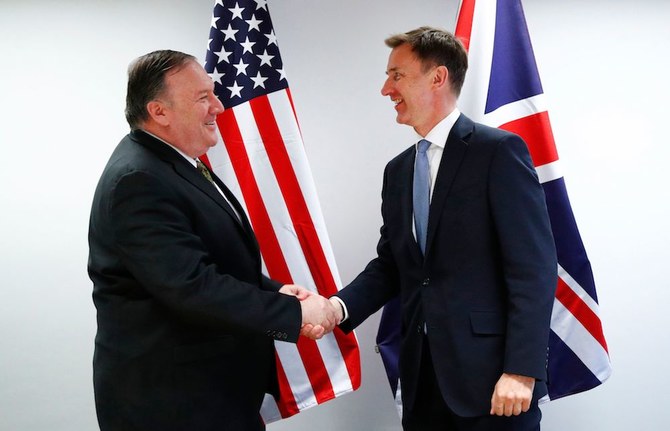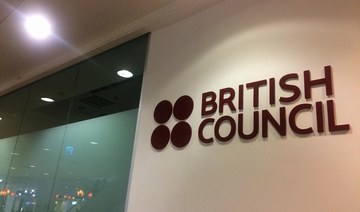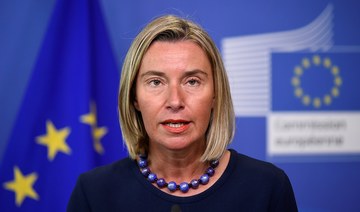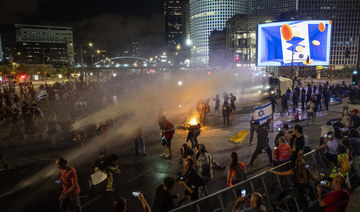BRUSSELS: Iran and the United States could trigger a conflict by accident in an already unstable Gulf region, Britain’s foreign minister said on Monday, as US Secretary of State Mike Pompeo held talks in Brussels with the main European powers on the crisis.
President Donald Trump is seeking to isolate Tehran by cutting off its oil exports after pulling out of a 2015 deal aimed at curbing Iran’s nuclear program. Trump has also beefed up the US military presence in the Gulf to pressure Iran.
While the European Union shares some US concerns about Iran, including over its involvement in the Syrian conflict, it still backs the 2015 nuclear deal, saying that it is in Europe’s own security interests.
“We are very worried about a conflict, about the risk of a conflict ... of an escalation that is unintended,” Britain’s Jeremy Hunt told reporters in Brussels ahead of the talks with Pompeo.
Britain, Germany and France are signatories to the 2015 deal and their foreign ministers were holding separate meetings in Brussels on Monday with Pompeo, who canceled a planned stopover in Moscow in order to brief the European allies on Washington’s latest moves.
Trump, who wants to force Tehran to agree a broader arms control accord, has sent an aircraft carrier and B-52 bombers to the Gulf in a show of force against what US officials have said is a threat to US troops in the region.
Iran says the strategy amounts to “psychological warfare” and a senior Iranian Revolutionary Guards commander on Sunday said Iran would retaliate to any aggressive US moves.
“TAKING DIFFERENT COURSES“
The US State Department billed Monday’s talks in Brussels as a chance “to discuss recent threatening actions and statements” by Iran.
German Foreign Minister Heiko Maas said he had told Pompeo during their Monday meeting: “We do not want it to come to a military conflict (between the United States and Iran).”
Maas avoided any public criticism of Washington, saying both sides wanted to ensure peace in the Middle East. But he said it was clear that Europe and the United States were “going about it in different ways ... taking different courses.”
Before his meeting with Pompeo, France’s Foreign Minister Jean-Yves Le Drian urged Europeans to remain united in support of the nuclear deal, which was signed by the United States, Britain, France, Germany, China and Russia, and which the European Union helped to negotiate.
For Europe, the tensions with the Trump administration mark a deepening split in transatlantic ties that were traditionally marked by close coordination on Middle East policy, despite sharp disagreements over the 2003 Iraq war.
Iranian President Hassan Rouhani warned last week that Tehran could resume enrichment at a higher grade if the European powers, China and Russia did not do more to circumvent punitive US measures on banking and energy to boost trade.
Hunt, who held talks with Maas and Le Drian on the margins of a regular EU meeting in Brussels, expressed concern about the risks of a nuclear arms race in the Middle East if Iran were to acquire such weapons.
“We need to make sure that we don’t end up putting Iran back on the path to re-nuclearization,” Hunt said, calling for “a period of calm so that everyone understands what the other side is thinking.”
EU foreign policy chief Federica Mogherini said the EU would continue to support the nuclear pact because Iran continued to comply with inspections and uranium production limits.
The EU is trying to implement a new channel to allow Iran to sell its oil and circumvent newly-instated US sanctions, but setting it up is proving complex.
Spain’s Foreign Minister Josep Borrell said Madrid was considering joining the special trade channel, known as INSTEX, which so far counts France, Germany and Britain as shareholders and could be operational by the end of June.
Britain warns of Iran-US conflict, Pompeo meets Europeans
Britain warns of Iran-US conflict, Pompeo meets Europeans

- Europe urged US not to further escalate tensions over Iran nuclear deal, with UK issuing a stark warning of risk of conflict
- Pompeo met counterparts from the 3 European signatories to the 2015 accord that curbed Iran’s nuclear ambitions in return for sanctions relief
Ukraine to get up to 100,000 shells in June: Czech official
Ukrainian forces said earlier this year they were so low on supplies that they were forced to ration ammunition, letting Russia seize ground
PRAGUE: Ukraine will receive 50,000-100,000 shells in June under a Czech-led initiative to buy ammunition for the war-ravaged country largely outside Europe, a Czech official said Thursday.
Tomas Kopecny, the Czech government envoy for Ukraine reconstruction, told reporters that Ukraine, battling a Russian invasion since February 2022, could get millions of shells if allies managed to collect the money.
“The first delivery under the umbrella of this Czech initiative will be in June, and it will be dozens of thousands of shells, between 50 and 100,” he said on the fringes of a meeting of NATO foreign ministers in Prague.
Ukrainian forces said earlier this year they were so low on supplies that they were forced to ration ammunition, letting Russia seize ground.
Russia has more recently launched a widescale offensive in northeastern Ukraine ahead of the delivery of US weapons that were approved after a long delay in Congress.
Besides the Czech Republic, Canada, Denmark, Germany, the Netherlands and Portugal have so far contributed some 1.7 billion euros ($1.8 billion) to buy 500,000 shells in the first phase, Kopecny said.
Ten other countries are “in the process” with talks for donations under way, he said.
In Prague for the NATO meeting, US Secretary of State Antony Blinken hailed the so-called Czech initiative, estimating that the effort will bring one million shells to Ukraine by the end of the year.
“Czechia’s leadership is really quite extraordinary,” Blinken said. “We’re not only stronger, we’re more likely to prevent — to deter — aggression when we’re united.”
Kopecny urged further contributions as Ukraine will need 200,000 shells a month in the next two years “just to make the balance” vis-a-vis Russia.
The necessary supplies will swallow “between seven and ten billion euros per year,” he said, adding the 500,000 shells obtained or pledged so far would suffice for two and a half months.
He said allies were competing for millions of rounds of ammunition produced outside Europe with Russia.
“It’s about speed,” he said. “It’s a market where the owner of a product wants to sell it at the highest price.”
Kopecny also slammed allies for a failure to use bank loans to finance the weapon supplies to Ukraine.
“It’s so frustrating when you compare it with the expenses and the loans the EU took for Covid. Hundreds of billions of euros. Easy. And here we’re struggling with hundreds of millions.”
Ukraine will receive 50,000-100,000 shells in June under a Czech-led initiative to buy ammunition for the war-ravaged country largely outside Europe, a Czech official said Thursday.
(Reuters/File)
Indian space startup launches first rocket with fully 3D-printed engine

- Rocket launched from India’s first private launchpad in Sriharikota
- Agnibaan has the first indigenously produced semi-cryogenic engine
NEW DELHI: An Indian startup launched the world’s first rocket with a single-piece 3D-printed engine on Thursday, marking another milestone in the country’s booming space economy.
The Agnibaan SOrTeD (Suborbital Tech Demonstrator) rocket weighing 575 kg and 6.2 meters long, was launched by Agnikul Cosmos from a private launchpad at the Satish Dhawan Space Centre in Sriharikota, off the Bay of Bengal.
India’s Prime Minister Narendra Modi took to social media to congratulate the team and mark the launch as a “remarkable feat which will make the entire nation proud.”
The feat was achieved “entirely through indigenous design and development,” the company said in a statement.
“The key purpose of this mission, which is also Agnikul’s first flight, is to serve as a test flight, to demonstrate the in-house and homegrown technologies, gather crucial flight data and ensure optimal functioning of systems for Agnikul’s orbital launch vehicle.”
It is powered by the only India-manufactured rocket engine to use both gas and liquid fuel.
“What Agnikul has achieved today, is nothing short of a historical milestone ... Agnibaan SOrTeD has got many firsts in its strides with being India’s first launch from a private launchpad, the first semi-cryogenic engine-powered rocket launch and the world’s first single-piece 3D-printed engine designed and built indigenously,” Lt. Gen. A.K. Bhatt, director-general of the Indian Space Association, told Arab News.
“This is a huge boost and a proud moment for India’s thriving private space industry and just a glimpse into what the future holds for us.”
India’s national space agency, the Indian Space Research Organisation, which has yet to fly a rocket with a similar engine, said Agnikul’s achievement was a “major milestone, as the first-ever controlled flight of a semi-cryogenic liquid engine realized through additive manufacturing.”
Agnikul, whose name is a combination of “fire” in Sanskrit (agni) and Hindi (kul) — was founded in Chennai, Tamil Nadu, in 2017.
The company has over 200 engineers and 45 scientists who previously worked at the ISRO and are associated with the National Centre for Combustion Research and Development at the Indian Institute of Technology-Madras.
India’s first privately developed rocket, from the company Skyroot, was flown from the ISRO’s launch site in 2022.
The ISRO’s chairman, Dr. S. Somanath, said the many firsts in Thursday’s launch “demonstrate the prowess of indigenous design and innovation” and motivate the agency to support startups and the private sector “to create a vibrant space ecosystem in the country.”
India has been establishing a significant presence in the global space industry over the past few years.
Having become the fourth nation to soft-land a spacecraft on the moon in August last year, it aims to put an astronaut on the lunar surface by 2040.
In September 2023, India launched its sun mission with the Aditya-L1 spacecraft, which in January reached Lagrange point — 1.5 million km from Earth — to observe the photosphere and chromosphere and study solar wind particles and magnetic fields.
To date, the US is the only other country to have explored the sun with the Parker Solar Probe launched in 2021.
ENDS
EU states agree ‘prohibitive’ tariffs on Russia grain imports

- The European Union has hit Russia with multiple rounds of sanctions
- The latest measure will “tackle illegal Russian exports of stolen Ukraine grain into EU markets,” the EU’s trade commissioner, Valdis Dombrovskis, said
BRUSSELS: EU states agreed on Thursday to impose “prohibitive” duties on grain imports from Russia in a bid to cut off revenues to Moscow for its war on Ukraine.
The European Union has hit Russia with multiple rounds of sanctions to inflict damage on Russia’s war chest following its all-out invasion of Ukraine in 2022.
The latest measure will “tackle illegal Russian exports of stolen Ukraine grain into EU markets,” the EU’s trade commissioner, Valdis Dombrovskis, said on social media.
The tariffs will also be applied to products from Belarus, which served as a staging ground for Russia’s attack on Ukraine.
But the tariffs will not apply to Russian grain transiting through the EU to countries outside the bloc, to ensure that food supplies for elsewhere, notably Africa and Asia, are not impacted. Russian fertilizer supplies were not targeted.
The European Commission proposed the measure in March. Under World Trade Organization rules, virtually all Russian grain has until now been exempt from EU import duties.
From July 1, the EU will increase “duties on cereals, oilseeds and derived products from Russia and Belarus to a point that will in practice halt imports of these products,” the council representing the EU’s 27 member states said.
The EU set this at a level of either around 90 euros (around $97) per ton for most cereals, or 50 percent of the value for other products.
“These measures will therefore prevent the destabilization of the EU’s grain market (and) halt Russian exports of illegally appropriated grain produced in the territories of Ukraine,” said Vincent Van Peteghem, Belgian minister for finance.
“This is yet another way in which the EU is showing steady support to Ukraine,” he added.
Russian agricultural imports into the EU burgeoned in 2023.
Last year, Russia exported 4.2 million tons of cereals and related agricultural products to the EU worth 1.3 billion euros.
And Russian grain exports to the EU rose from 960,000 tons in 2022 to 1.5 million tons last year after a surge in Russian production.
Despite the figures, it comprises only a very small share of the EU’s supply of such products, around one percent of the European market.
In stark contrast, domestic suppliers provide 300 million tons annually.
The EU has approached punitive action against Russia’s agricultural or fertilizer sector with great caution, fearing any moves that could hurt the global cereal market as well as food security in Africa and Asia.
But Ukrainian President Volodymyr Zelensky complained to EU leaders earlier this year, arguing it was unfair Russian grain maintained unrestricted access to their markets while Ukrainian imports faced limits.
Russia at the time warned against the tariffs. “Consumers in Europe would definitely suffer,” Kremlin spokesman Dmitry Peskov said in March.
Dome of Rock replica turns remote Sri Lankan town into tourist site

- It was inaugurated in Kattankudy, Eastern Province, in 2022
- The site has since boosted local halal tourism businesses
KATTANKUDY: A bright gold dome mounted on an octagonal blue arcade looks like the Dome of the Rock, but the background is a modern tropical neighborhood in a coastal Sri Lankan town.
The building is a mosque modeled on the seventh-century shrine in the Al-Aqsa Mosque compound in East Jerusalem — the third holiest site in Islam, after the Grand Mosque in Makkah and the Prophet’s Mosque in Madinah.
Built in Kattankudy, a township near the city of Batticaloa in Sri Lanka’s Eastern Province, the three-story replica was inaugurated in December 2022.
Muslims constitute about 10 percent of Sri Lanka’s 22 million population, which is predominantly Buddhist, but in Kattankudy and neighboring areas they are a majority.
“For Friday prayers, around 2,000 to 3,000 people would pray here, on the three stories, and outside also ... In Ramadan, (there is) also a big crowd,” Mahamood Lebbe Alim Mohamed Hizbullah, the mosque’s caretaker and former governor of the Eastern Province, told Arab News.
But the biggest crowds flock to the coastal town during weekends, he said, as the mosque has boosted local businesses offering halal food and accommodation.
Financed from donations, it is becoming a main tourism attraction for the region’s Muslims, most of whom may never be able to visit the original site in Palestine.
“The Muslim community, after the Easter attack, is finding it really difficult to travel,” Hizbullah said, referring to the deadly 2019 bombings on churches in Colombo.
While the attacks were claimed by Daesh militants, they prompted the Sri Lankan government to ramp up restrictions on the Muslim community.
No such restrictions are present in Kattankudy, where most of the establishments and properties are Muslim-run.
“This has become a tourist destination in the Eastern Province ... (Praying here) you feel so comfortable, and you feel you are in a different place,” said Abdul Rahman Mansoor, former deputy mayor of nearby Kalmunai city.
“People like me, we are not going to Palestine, we will not get the chance, but coming here ... gives us confidence and gives us hope.”
Police begin dismantling pro-Palestinian camp at Wayne State University in Detroit

- Television footage showed campus police and Detroit police officers in riot gear tearing down fencing
- US Rep. Rashida Tlaib, a Michigan Democrat, had visited the encampment to offer support to the protesters
DETROIT: Police began dismantling a pro-Palestinian encampment Thursday at Wayne State University in Detroit, two days after the school suspended in-person classes and encouraged staff to work remotely to avoid any problems with the protesters’ encampment.
Television footage showed campus police and Detroit police officers in riot gear tearing down fencing before they removed the protesters and started breaking down tents erected last week on green space near Wayne State’s undergraduate library.
After police began removing the encampment, the protesters chanted, “There’s no riot here, why are you in riot gear?” The protesters later began marching on Wayne State’s campus, and some people appeared to clash with officers, WXYZ-TV reported.
Protest camps sprang up across the US and in Europe as students demanded their universities stop doing business with Israel or companies that they say support its war in Gaza. Organizers seek to amplify calls to end Israel’s war with Hamas, which they describe as a genocide against the Palestinians.
Wayne State has 16,000 undergraduate students but fewer during the summer term. The protesters have demanded that the school divest from weapons manufacturing companies supplying Israel, provide a full disclosure of investments and cease delegation trips to Israel.
US Rep. Rashida Tlaib, a Michigan Democrat, had visited the encampment to offer support to the protesters.
Wayne State suspended in-person classes Tuesday and encouraged staff to work remotely. School spokesperson Matt Lockwood said there had been “public safety concerns,” especially about access to certain areas.
“We have told the organizers to remove the encampment several times and they have declined to do so,” Lockwood said Tuesday.
A message on Wayne State’s website said that the school would remain on “remote operations” Thursday, citing “the ongoing public safety issue.”
Ali Hassan, who represents WSU Students for Justice in Palestine, told WXYZ-TV this week that he believed the university’s shift to remote learning means the administration is taking notice of the student protests.
“The reason that they went remote is because we have put pressure on them,” he said.
The University of Michigan, west of Detroit in Ann Arbor, on May 21 broke up a similar encampment after 30 days.




















